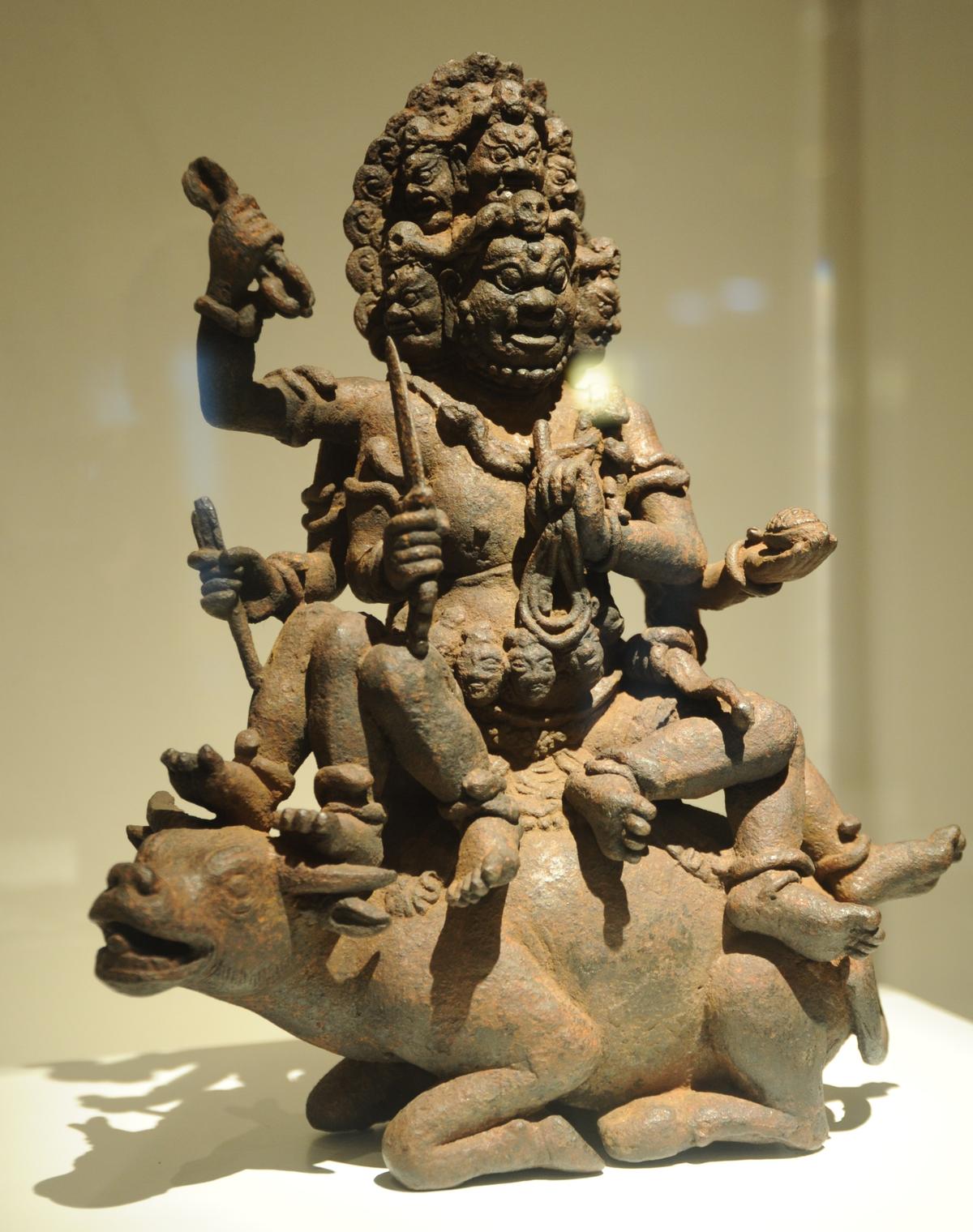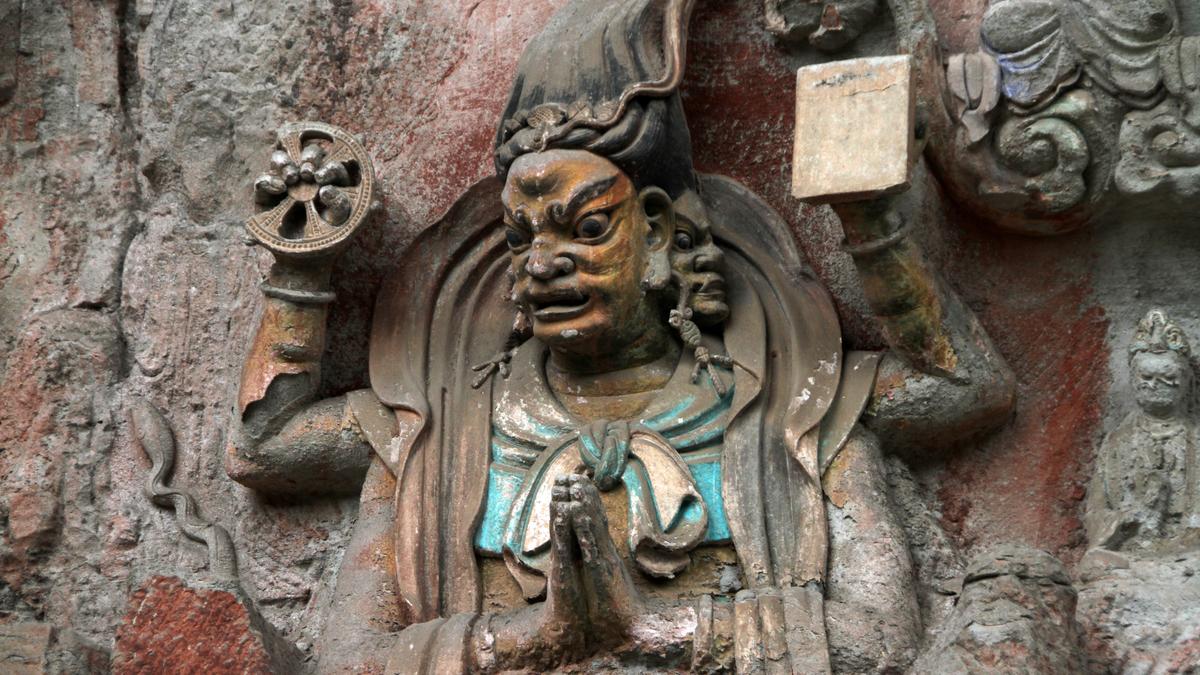The Ocean Sutra is a 1,500-year-old Mahayana Buddhist manuscript that shows a strong influence of Tantrik Shaiva ideology. It was composed in Central Asia at a time when Buddhism, which rose 2,500 years ago and had overshadowed Vedic ritual practices, began facing pushback from the rise of temples dedicated to Shiva and Vishnu.
While Buddha had promoted monasticism and celibacy, Shiva’s story celebrated sexuality. Vishnu balanced the two extreme views.
This pushback can be traced to the epic Mahabharata, compiled around 100 BCE, which first narrates the tale of Shiva destroying Daksha’s yagna (a ritual in front of a sacred fire). By 500 CE, in Agni Purana, Buddha was presented as a form of Vishnu — taken to trick demons into giving up Veda, to follow the monastic path instead. This enabled Shiva to raise his bow and destroy the demons’ three flying cities with a single arrow. Thus, Shiva and Buddha were seen as doing anti-Vedic activities, for different reasons: Shiva, to be included in the newly emerging Hindu pantheon, and (Vishnu as an imposter) Buddha, to help the gods defeat demons. The supremacy of Veda was endorsed by these stories popularised by Brahmins.
Forever in contrast and conflict
Buddha shuns marriage; Shiva is wooed into marriage first by Sati, the priest’s daughter, and then Parvati, the mountain princess. Buddha covered himself with robes; Shiva wandered naked with matted hair, smeared with ash. Buddhism emerged in Bihar, 2,500 years ago; Shaivism probably emerged in Mauryan times in the pine wood forests of the Uttarakhand region. We can state this because, as per the Mahabharata, Daksha’s yagna takes place at Gangadwara, identified as modern Haridwar. Also the earliest Shiva temples, built in central India during the Gupta times, map the Uttarakhand terrain, with the roof representing the Himalayas, and the gateway flanked by the river goddesses Ganga and Yamuna.
Buddha was once a prince named Siddhartha. His celibacy was a code for avoiding the trap of pleasure. Shiva is worshipped as Siddheshwar, the lord of Siddha — his magical powers obtained by celibacy combined with Tantrik practices. The Buddhist way spoke of restraint. But Shiva worshippers, the Tantrikas known as Pashupata, popularised the idea of yogis who can wander naked on snowy mountains, who can make childless women pregnant, who can bring rain to barren lands, and kill enemies with the glance of an eye. In other words, sexuality became about power, not renunciation.
Buddhist scholars have noted that in the early days, many people mocked Buddha’s celibacy and questioned his masculinity. This may have been amplified by the worship of Shiva’s phallic symbol. This led to the compilation of tales of Buddha’s marriage and fathering of children, and even his prowess as a lover and the impact he made on women, a trope later found in the stories of Krishna.
Among the 32 marks on the Buddha’s body — his long ears, his webbed hands, and the like — is the perfect male genitalia, indicated by a bump on the robes. This explicitness reveals the anxiety of monks in a world where Tantra visualised the world as the outcome of mystical sexual union.

Venerated as Yamāntaka
Under the influence of Tantra, Buddhism transformed. New forms of Buddha-to-be (Bodhisattva) appeared as Mahakala Bhairava, the guardian of the Buddhist way, who, ironically, was visualised as being as violent and erotic as Rudra-Shiva. Both Buddha and Shiva were venerated as Yamāntaka, killer of the god of death, liberator from the wheel of rebirth.

The ‘destroyer of death’ riding a water buffalo
| Photo Credit:
WikiCommons
Ocean Sutra is amongst the first texts to reveal the influence of Tantrik sexuality and magic on Buddhism. It tells the story of courtesans accusing Buddha of not having genitalia, and thus of not being man enough for his wife. To counter this accusation, Buddha presents himself nude. The description that follows is rather colourful — a vision of elephants and horses and lotus flowers. The courtesans are humbled and they become Buddhist nuns.
In another story, an abusive courtesan is visited by a handsome man who challenges her to satisfy him. They make love over days. By the third day, she is satisfied and wants him to leave, but he is not content and so continues, until he dies. Even in death, his corpse clings to her body, refusing to let go, until it rots. She is forced to pray to Buddha and ask for his help. He liberates her and she becomes Buddhist.
Ocean Sutra is known today through its Chinese translations. It may have played a key role in reshaping Chinese politics by challenging the misogyny and patriarchy of the Confucian court with a new Buddhist notion of kingship, and enabling the meteoric rise of Lady Wu of the Tang dynasty, in the 8th century. She was the first and only lady to be declared Emperor of China. She also imagined the Buddha and the Bodhisattva as women, acknowledging the role of sexuality in the world of celibacy.
Devdutt Pattanaik is the author of 50 books on mythology, art and culture.
Published – November 14, 2024 01:42 pm IST





